Mr Shojiro Ishibashi started his business in the 1920s making rubber-soles for Jika–Tabi socks, and is generally credited with the actual invention of this popular type of footwear in Japan. The business also developed a trading offshoot dealing with the import & export of motorcar parts, which sought to expand the rubber moulding theme to complement its vehicle interests. It produced its first automotive tyre on April 9th 1930 from the Jika–Tabi moulding plant, as the new ‘Tyre Division’ of the Japanese Tabi Socks manufacturing company.
If you’re a little unclear as to what ‘Tabi’ socks are: worn by both men and women, Tabi are traditional Japanese ankle-high socks with a separation between the big toe and other toes; Jika–Tabi are a heavier duty version of the sock, generally with rubber soles.
Within a year, this new tyre moulding business was registered as an incorporated company ‘Kabushiki–gaisha Burijisuton’ in the city of Kurume, Fukuoka prefecture, Japan on 1st March 1931. A calque translation and transposition from the founder’s Japanese name Ishibashi provides the company title in English language that will probably be more familiar to people in the west: ishi = stone / bashi = bridge, which we would more easily recognise as Bridgestone. The company evolved and developed its own moulding processes and methods independently of established North American and European technology, and initially experienced many production, manufacturing, and sales difficulties as a result, before achieving the required processes and quality standards to secure sales in domestic and export markets toward expanding the business.
As Japan entered into World War II, restrictions came into effect throughout the country and tyre production fell within the regulations of military jurisdiction, resulting in nearly all the company’s output being used to satisfy demand from the armed forces. Conflict formally ended with the surrender signed aboard the USS Missouri battleship BB-63 at Yokohama Bay on 2nd September 1945, but Bridgestone’s business was left devastated by the war. The Tokyo headquarters was destroyed in a bombing raid, and all overseas assets were lost, though the manufacturing facilities at Kurume and Yokohama survived unscathed, so production was able to resume almost immediately. Recognising a need for cheap social transport in the post-war period, Shojiro Ishibashi founded the Bridgestone Bicycle Manufacturing Company in 1945, which began producing bicycles in 1946. Demand shortly began to develop for economy motorised vehicles and, within three years, Bridgestone was looking to a new sunrise in the manufacture of powered bicycles.
In 1949 the business was re-titled as the Bridgestone Cycle Company and in 1950 a contract was signed with Fuji Seimitsu Jogyo (Fuji Precision Engineering Co.) to manufacture and supply small clip-on power units to fit Bridgestone Cycles. These cyclemotor engine kits were initially sold separately from the bicycles but in 1952 the first complete Bridgestone BS-21 ‘Bambi’ Motorised Cycle became available. This was a small 26cc two-stroke unit fitted over the rear wheel of a Bridgestone bicycle, with a friction drive onto the rear tyre.
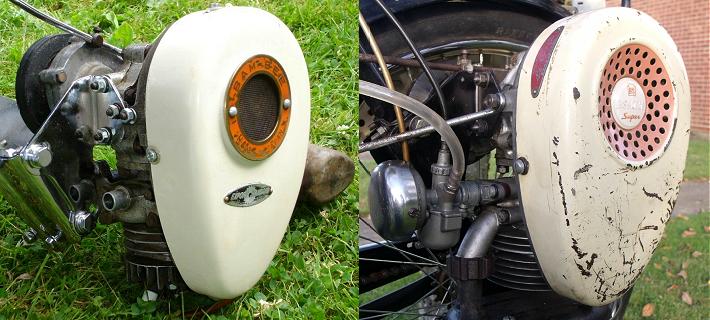
Left: Bridgestone BS-31 ‘Bam-Bee’
Right: Bridgestone BS-41
Engine capacity was later expanded to 38.5cc for the model BS-31, then again to 49cc for the model BS-41, which could be mounted on various types of Bridgestone bicycles. All the cyclemotor models sold well in Japan, which helped to establish Bridgestone’s foundation as new motor cycle manufacturer.
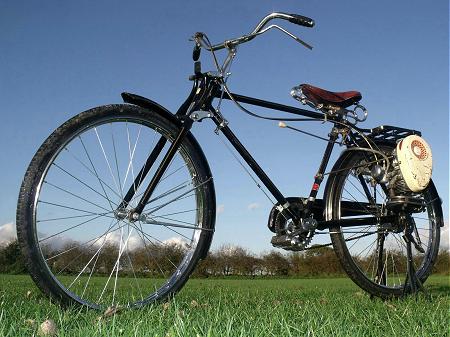 IceniCAM has been incredibly lucky to secure one of
these Bridgestone BS-41 cyclemotors for this feature, since these
machines weren’t really exported, and there are reportedly
very few outside of Japan. This example was passing through
ownership from a collection in Ireland to another collection in
New Zealand, and the deal was that if the workshops could get it
going between shipping, then we could have it for a road test and
photo shoot before sea-freighting the bike onto New
Zealand. We have a rare opportunity to study a most unusual
machine, so it’s worth making a few observational notes
…
IceniCAM has been incredibly lucky to secure one of
these Bridgestone BS-41 cyclemotors for this feature, since these
machines weren’t really exported, and there are reportedly
very few outside of Japan. This example was passing through
ownership from a collection in Ireland to another collection in
New Zealand, and the deal was that if the workshops could get it
going between shipping, then we could have it for a road test and
photo shoot before sea-freighting the bike onto New
Zealand. We have a rare opportunity to study a most unusual
machine, so it’s worth making a few observational notes
…
The frame carries serial number 905963, and is marked ‘Meimon Okubo Works’, with a further headstock badge indicating ‘TOW Works’. Fork components are liberally marked with ‘BS’, and a ‘Bikestar King’ decal on the suspension unit in the girder fork set. The KCL leather saddle is indicated as produced by Kuwahara Co. Ltd, and tyres are the original Japanese Hoshin 26 × 1¾. Bridgestone sure liked their little decals all over the cycle at this time, and it’s something of a surprise that these labels appear in a mixture of Japanese and English text, considering the cyclemotor was primarily produced for home market sales and seemingly never intended for export to the west. In the ’50s to early ’60s the cycle, motor cycle and automotive manufacturers in Japan were quite inexplicable, since in the main, even though they weren’t exporting vehicles to the west about this time, the industries often tended to use English language labels. We don’t know why…
The engine is a fan-cooled BS-41, serial number F8 706845, fitted with a Mikuni M-11 carburetter from a type-392 design licensed from Amal. Designed by Bridgestone to fit their cycle frame, the Fuji-manufactured motor is a somewhat unusual cyclemotor. Largely obscured by the cooling fan shroud, the engine is inverted so the cylinder points downward. Since the carburetter is forward facing, its intake is covered with a shield. The cylinder comprises a flat ‘top’ fin at the bottom of the inverted motor, which the pan silencer practically butts against, so the easily accessible spark plug seems to screw into the back/side of the cylinder at 90°—which wouldn’t appear to be an expected position for a performance engine…
Slung beneath the right side of the rear carrier, the long fuel tank has a clear vertical pipe at the back below its cap, so you can see the actual fuel level. The tank is marked with a transfer ‘BS-Motor, Fuji Precision Machinery Co. Ltd. Suginami, Tokyo’. A Taiyou fuel tap with gravity filter (marked BS, so seemingly made for them) bolts under the tank, unscrew the thimble valve to turn the fuel on.
The right handlebar carries a dual-lever control to the motor, with the smaller top lever for the choke and the longer lower lever for the throttle. There is no decompresser on this motor, so a little technique can help to get the motor spinning against compression or the rubber drive roller might slip. The drive roller is comprised of a large diameter wheel about four inches across, covered with a rubber tyre that runs on the left-hand inside face of the rear wheel rim. Maintain a light constant pressure on a pedal to ease the piston through the compression phase, then push hard down and the motor spins on under its own momentum. If you’re lucky it might fire, but invariably won’t. Keep going as we don’t know the optimum choke & throttle settings for starting. It takes several attempts before we manage to get the motor to catch and keep running.
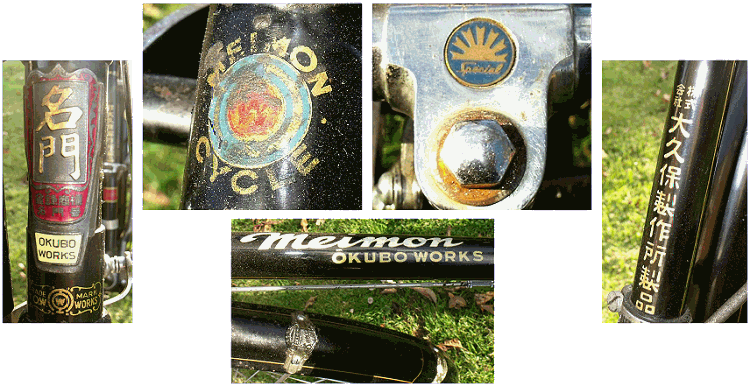
While the exhaust produces a quite loud and tinny bark (which is not untypical of pressed-steel type pan silencers), there’s also a certain amount of reflected mechanical noise coming back at us from the walls in the workshop. The mechanical noise probably comes from the reduction gear housing to the drive roller. Since this whole mechanism rotates on the engine to engage the drive, we presume this is lubricated by a contained heavy oil or grease reservoir.
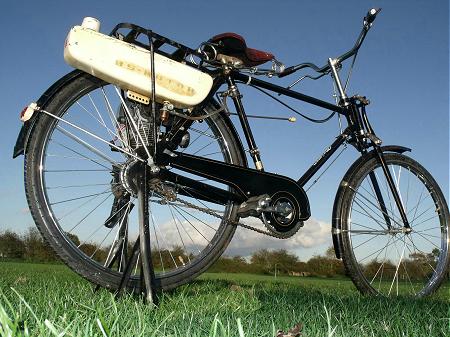 There’s a long lever just below the top frame
tube, which connects to the reduction housing and engages the
drive roller. The lever locates in a three-position latch
on the frame; lowest position disengages the drive for cycling,
and can be operated as a clutch when riding; second position
lightly engages the drive for dry weather running, and offers
slightly more speed capability and better fuel economy due to
lower frictional losses; position three provides high pressure of
the drive roller on the rim for wet weather running.
There’s a long lever just below the top frame
tube, which connects to the reduction housing and engages the
drive roller. The lever locates in a three-position latch
on the frame; lowest position disengages the drive for cycling,
and can be operated as a clutch when riding; second position
lightly engages the drive for dry weather running, and offers
slightly more speed capability and better fuel economy due to
lower frictional losses; position three provides high pressure of
the drive roller on the rim for wet weather running.
Having started our bike on its stand and warmed the motor, we disengage the drive and grip the brake lever to stop the wheel spinning. The rod linkage operates a band brake on the rear hub, and seems to stop the wheel effectively enough, but we do wonder how this might perform on the road since this is the only means of arresting progress—there is no front brake! Bridgestone apparently made their cyclemotors with only a single rear brake. Some countries (like the UK), demand two independent braking systems for highway use, so single-brake vehicles like the Bridgestone would require the addition of a second braking set to qualify for use on public roads.
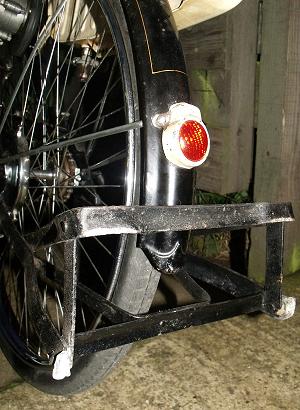 We nudge the bike forward, which drops down as it
rolls off the monstrous rear stand. The mighty stand
doesn’t seem capable of pulling itself up by its own
springing, so needs a nudge with your foot to make sure its
securely returned—you really don’t want that stand
grounding on a corner because it looks very unforgiving! We
walk the bike out to the road with the engine ticking over, cycle
lightly away, and then ease up the throttle while clutching in
the drive lever with our left hand.
We nudge the bike forward, which drops down as it
rolls off the monstrous rear stand. The mighty stand
doesn’t seem capable of pulling itself up by its own
springing, so needs a nudge with your foot to make sure its
securely returned—you really don’t want that stand
grounding on a corner because it looks very unforgiving! We
walk the bike out to the road with the engine ticking over, cycle
lightly away, and then ease up the throttle while clutching in
the drive lever with our left hand.
Our first impression of riding the Bridgestone is that it feels fairly highly geared, and seems quite torquey from low revs, so maybe the BS-41 might muster a fair touch of speed? Reaching down to de-clutch the drive lever approaching junctions isn’t a particularly natural or easy operation, but we get by, then pedal off and re-engage the drive in a wobbly kind of way, before pointing our course and throttling up. Our Bridgestone has no speedometer, so it proves difficult to gauge our progress on such an unfamiliar machine, while our shadowing pace vehicle is the only one that has any real idea of our true performance. The BS-41 pulls up to a lightly revving cruising speed with a smooth and low flat tone droning from the silencer. All mechanical noise is lost in the open air and the engine runs pleasantly along in an easy and relaxed manner.
Putting on more throttle creates a little more induction and exhaust tone, but delivers little more performance. The motor won’t readily pull more revs under load on the flat, and simply labours against its high drive ratio to maintain a steady pace. Cruising speed is up to anything you can work the motor up to under the prevailing conditions. The motor runs steadily along at relatively low revs, and even on full throttle, is never going to be over revved in normal operation. You can feel the motor labouring harder, and then fading back against a light incline, though also picking up a little more pace on light down-slopes. It’s similarly affected against headwinds or with tailwinds so, like so many small capacity and low powered machines, is much influenced by the forces of nature and gravity.
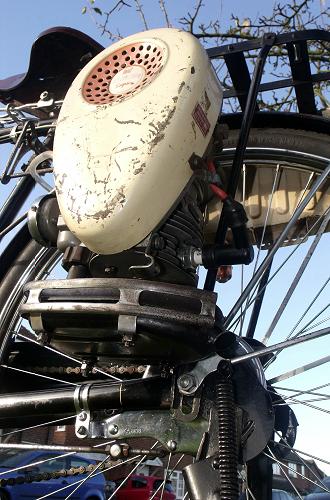 Once
warmed up, the BS-41 motor hums along quite smoothly with
constant two-stroke running, and little discernable
vibration. We were quite impressed by the feel of the
motor, and it did seem somewhat strange to be riding such a low
revving Japanese motor, after so many years of experiencing its
later high revving cousins. Turning into the main straight
for our fastest run, we notch back the drive lever to dry-running
position for full race mode, pull back the lever to full
throttle, building up speed to enter the downhill section, dip
into the best crouch we can manage (the pull-back style
handlebars are similar to ‘North Road’ pattern, and
didn’t really make a racing crouch an easy posture to
assume), and steadily the revs creep higher … higher
… then seem to plateau as the transfer and exhaust porting
gas exchanges appear to get in a tizzy, so that seems to be the
ceiling. The BS-41 motor was still running smoothly at
speed, and still feeling as if it wasn’t over revving in
any way, with relatively little vibration to speak of. It
did seem to manage the fast run well, and certainly never
indicated any complaint!
Once
warmed up, the BS-41 motor hums along quite smoothly with
constant two-stroke running, and little discernable
vibration. We were quite impressed by the feel of the
motor, and it did seem somewhat strange to be riding such a low
revving Japanese motor, after so many years of experiencing its
later high revving cousins. Turning into the main straight
for our fastest run, we notch back the drive lever to dry-running
position for full race mode, pull back the lever to full
throttle, building up speed to enter the downhill section, dip
into the best crouch we can manage (the pull-back style
handlebars are similar to ‘North Road’ pattern, and
didn’t really make a racing crouch an easy posture to
assume), and steadily the revs creep higher … higher
… then seem to plateau as the transfer and exhaust porting
gas exchanges appear to get in a tizzy, so that seems to be the
ceiling. The BS-41 motor was still running smoothly at
speed, and still feeling as if it wasn’t over revving in
any way, with relatively little vibration to speak of. It
did seem to manage the fast run well, and certainly never
indicated any complaint!
The revs and speed naturally fell back as the downhill section ran out … so how did our Bridgestone fare?
Consultation with the pacer back at base revealed our results. On flat the bike usually pulls around 20mph, creeping a little above or below this speed according to prevailing conditions. Pace generally fades down to 12 or 14mph against light gradients, though rarely demands rider assistance except against the steeper slopes. Our downhill run clocked 28–29mph, and the way the transfer and exhaust gas scavenging got all confused at these revs and started to hold the bike back with four-stroking breakdown, our feeling was that 30mph would probably not be attainable, though the Bridgestone gave a pretty good showing for a cyclemotor to achieve just under that speed. Operation of the single rear band-brake proved adequate for the requirements of our test. Handling proved stable enough at speed, though a little wobbly at low cycling pace and particularly when trying to work the lever clutching operations.
Our Bridgestone cyclemotor didn’t have any obvious generator lighting output, and was not equipped with a lighting set.
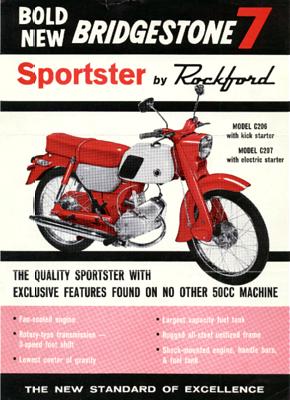 The
rear carrier comprised an unusual combination of heavy-gauge
formed-steel strip, and light pressed plates. If you tried
lifting the bike by the pressed plated they would be readily
prone to bend, and you might be inclined to do this for putting
the bike on and off the stand. If you were dealing with a
lightweight cycle, then this probably wouldn’t be much of
an issue, but trying to lift the back of the Bridgestone felt
like it was screwed to the floor! This certainly feels to
be one heavy cyclemotor, and we were speculating whether it might
have been built from scaffolding pipe rather than lightweight
Reynolds 531 tubing? Putting the front wheel on the scales,
1st 8lb (10kg).
Put the rear wheel on the scales, 4st
(25kg), which is a fair weight to
actually be trying to lift with one hand. It looks like a
bicycle, but it weighs like a boat anchor!
The
rear carrier comprised an unusual combination of heavy-gauge
formed-steel strip, and light pressed plates. If you tried
lifting the bike by the pressed plated they would be readily
prone to bend, and you might be inclined to do this for putting
the bike on and off the stand. If you were dealing with a
lightweight cycle, then this probably wouldn’t be much of
an issue, but trying to lift the back of the Bridgestone felt
like it was screwed to the floor! This certainly feels to
be one heavy cyclemotor, and we were speculating whether it might
have been built from scaffolding pipe rather than lightweight
Reynolds 531 tubing? Putting the front wheel on the scales,
1st 8lb (10kg).
Put the rear wheel on the scales, 4st
(25kg), which is a fair weight to
actually be trying to lift with one hand. It looks like a
bicycle, but it weighs like a boat anchor!
Bridgestone progressed from cyclemotors to motor cycles in 1958, constructing a new Ageo Plant in Ageo city, Saitama prefecture, and after incorporating the small engine division of Prince Motor Co. Ltd (which was an associated company), began manufacturing motor cycles under the name of Bridgestone Champion. Bridgestone abandoned production of its motorised cycles in 1960 when sales plummeted as the market moved on to the Honda Cub, but continued with a varied range of highly rated quality motor cycles up to 1971, when it withdrew completely from motor cycle manufacturing.
Fuji Precision Engineering Company (which manufactured the cyclemotor engines for Bridgestone), still continues, though now as part of the Nissan Motor Co.

